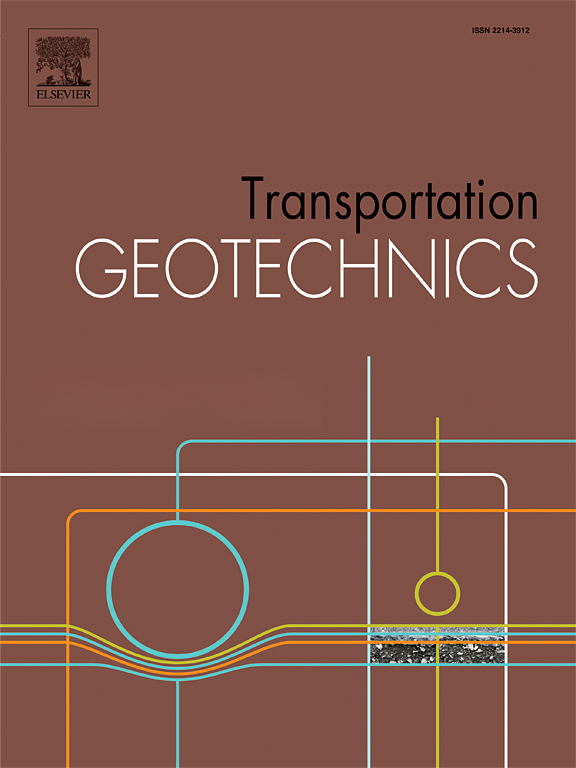Stabilization of expansive road subgrades with waste paper sludge: Resilient modulus, ANN and modeling approach
IF 4.9
2区 工程技术
Q1 ENGINEERING, CIVIL
引用次数: 0
Abstract
Stabilization of expansive subgrades is a crucial issue for transportation geotechnics in the development of sustainable approaches in road construction. This study was the first ever to investigate the effect of waste paper sludge (WPS) on the resilient modulus (Mr) parameters of three different expansive subgrades with different shrink/swell and bearing capacities. Repeated load tests were performed on clean soils and soils with different ratios of WPS to determine the change in the Mr values with WPS. Scanning electron microscope (SEM) and energy dispersive X-ray spectroscopy (EDX) analyses were performed on soil specimens to reveal the effectiveness of WPS at the microstructure level. Additionally, different artificial neural network (ANN) models were developed to estimate the Mr values of the expansive road subgrades stabilized with WPS. Furthermore, a numerical model was created to simulate the behavior of a typical road platform constructed with WPS-stabilized subgrade soil using the Plaxis 2D finite element analysis program. The experimental results indicated that the addition of WPS up to 9% resulted in a significant increase in the Mr values of subgrade soils. Microstructural analyses of the samples giving the highest hardness performance revealed that the dispersed and porous structure of pure soils transformed into a denser, less porous and flocculated structure after WPS stabilization. The developed ANN models showed better performance compared to multiple regression (MR) with higher R2 values and lower error parameters, which was confirmed by statistical parameters. Plaxis 2D analysis results showed a more rigid road structure formation with less deformation compared to clean soils through WPS stabilization. The findings of this research are expected to offer an understanding of considering the stabilization of expansive subgrades with WPS, thereby promoting sustainable highway construction and approaches.
废纸污泥膨胀路基的稳定:弹性模量、人工神经网络和建模方法
膨胀路基的稳定是交通土工技术在道路建设可持续发展中的关键问题。本研究首次研究了废纸污泥(WPS)对三种不同收缩/膨胀和承载能力的膨胀路基弹性模量(Mr)参数的影响。在清洁土壤和不同WPS配比的土壤上进行重复加载试验,以确定Mr值随WPS的变化。通过对土壤样品的扫描电镜(SEM)和能量色散x射线能谱(EDX)分析,揭示了WPS在微观结构水平上的有效性。此外,还建立了不同的人工神经网络模型来估计WPS稳定的膨胀道路路基的Mr值。在此基础上,利用Plaxis 2D有限元分析程序建立了wps稳定路基土构成的典型道路平台的数值模型。试验结果表明,当WPS添加量达到9%时,路基土的Mr值显著升高。对硬度最高的土样的微观结构分析表明,经WPS稳定后,纯土的分散多孔结构转变为更致密、多孔性更少的絮凝结构。通过统计参数证实,所建立的人工神经网络模型具有较高的R2值和较低的误差参数,其性能优于多元回归(MR)。Plaxis二维分析结果表明,与清洁土相比,通过WPS稳定的道路结构形成更加刚性,变形更小。本研究的结果有望为考虑使用WPS稳定膨胀路基提供理解,从而促进可持续公路建设和方法。
本文章由计算机程序翻译,如有差异,请以英文原文为准。
求助全文
约1分钟内获得全文
求助全文
来源期刊

Transportation Geotechnics
Social Sciences-Transportation
CiteScore
8.10
自引率
11.30%
发文量
194
审稿时长
51 days
期刊介绍:
Transportation Geotechnics is a journal dedicated to publishing high-quality, theoretical, and applied papers that cover all facets of geotechnics for transportation infrastructure such as roads, highways, railways, underground railways, airfields, and waterways. The journal places a special emphasis on case studies that present original work relevant to the sustainable construction of transportation infrastructure. The scope of topics it addresses includes the geotechnical properties of geomaterials for sustainable and rational design and construction, the behavior of compacted and stabilized geomaterials, the use of geosynthetics and reinforcement in constructed layers and interlayers, ground improvement and slope stability for transportation infrastructures, compaction technology and management, maintenance technology, the impact of climate, embankments for highways and high-speed trains, transition zones, dredging, underwater geotechnics for infrastructure purposes, and the modeling of multi-layered structures and supporting ground under dynamic and repeated loads.
 求助内容:
求助内容: 应助结果提醒方式:
应助结果提醒方式:


